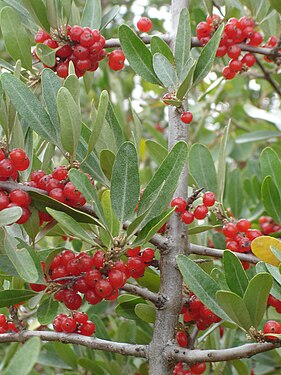Shepherdia argentea
| Habit | shrub
| |
|---|---|---|
| Height: | ⇕ | 12 ft"ft" can not be assigned to a declared number type with value 12. |
| Width: | ⇔ | 12 ft"ft" can not be assigned to a declared number type with value 12. |
| Lifespan: | ⌛ | perennial |
| Exposure: | ☼ | sun |
|---|---|---|
| Features: | ✓ | deciduous |
| USDA Zones: | 2 to 9 | |
| Flower features: | ❀ | white |
|
argentea > |
Shepherdia argentea (Silver Buffaloberry or Bull berry, thorny buffaloberry) is a species of Shepherdia, native to central North America from southern Canada (Alberta, Saskatchewan, Manitoba) south in the United States to northern California and New Mexico.[1]
It is a deciduous shrub growing to 2–6 m tall. The leaves are arranged in opposite pairs (rarely alternately arranged), 2–6 cm long, oval with a rounded apex, green with a covering of fine silvery, silky hairs, more thickly silvery below than above. The flowers are pale yellow, with four sepals and no petals. The fruit is a bright red fleshy drupe 5 mm in diameter; it is edible but with a rather bitter taste.[2]
Read about Shepherdia argentea in the Standard Cyclopedia of Horticulture
|
|---|
|
Shepherdia argentea, Nutt. (L. argentea, Greene). Buffalo Berry. Upright shrub, or sometimes almost tree-form, reaching 18 ft. tall, thorny, the young growth silvery tomentose: lvs. oblong, cuneate-oblong or oblong-lanceolate, silvery on both sides: fls. yellowish, in dense small fascicles at the nodes: fr. globular or ovoid, about 1/4 in. long, red or yellow, acid, edible. Kans. to Minn., west and north. Buffalo berry (Shepherdia argentea, Nutt. Lepargyrsea argéntea, Greene). Eleagnacese. A shrub 6 to 18 feet in hjght, native from Manitoba and Saskatchewan south to Colorado, Nevada and New Mexico, now grown in the upper Mississippi Valley and northward for its abundant acid fruits. The buffalo berry was brought into use early, mention being made in Hovey's Magazine of Horticulture for 1841, page 251, of its being frequently cultivated. It is a handsome ornamental shrub, with silvery foliage and red berries. Occasional plants are found with yellow fruit. The plant is dioecious; therefore, care should be taken, if fruit is desired, to plant both staminate and pistillate plants. Western nurserymen are beginning to offer these two kinds of plants separately in the ratio of one staminate to four pistillate plants, but the best proportion is not yet known. Many persona who plant the buffalo berry are disappointed ?? securing only one sex. The staminate or male plants may be known in their winter condition by the dense clusters of rounded flower-buds; the pistillate or female plants by the smaller, flattened, fewer, more slender flower- buds. The fruit varies greatly in size, quality and season, and is gathered in large quantities for culinary use. It makes a delicious jelly. Some berries are of sprightly flavor, good for eating out of hand. They can also be dried for winter use. The fruit is generally considered better when touched by frost, lees sugar being required. The name is said to have come from the custom of eating the berries as a sauce with buffalo meat in the early days. The buffalo berry makes a fine thorny hedge, that is both useful and ornamental. It is found that sprouts received as dug up in the native thickets from various parts of the Northwest do not always transplant satisfactorily; a year in a nursery row gives them better roots and secures an even stand when set in their permanent place. Seedlings are better rooted. Seedlings are easily raised from seed washed free from the pulp in the fall and stratified for winter, keeping in sand in a box buried just beneath the surface in a well-drained spot in the garden. There should be holes in the box for free drainage and the planting should be done very early in the spring. In Bulletin No. 88, June, 1904, of the South Dakota Experiment Station, Plate 19 shows a field of 7,500 buffalo berry plants of the first generation under cultivation. These plants were raised from seed gathered along the Missouri River of South Dakota, where buffalo berries are especially abundant. However, under cultivation the plant does not respond, as regards early bearing, as quickly as its near relative the Siberian sandthorn (Hippophae rhamnoides). It was found that the buffalo berries can be worked on the Russian form of oleaster (Elxagnus angustifolia). The fault of the buffalo berry is its small-sized fruit and the difficulty of gathering it, owing to its numerous thorns, but it has been and is an abundant source of pleasant fruit to thousands of settlers in the newer regions of the West. The fruit varies greatly in size and degree of acidity, affording opportunity for selection work in its native home along the Missouri River and tributaries.
|
Cultivation
- Do you have cultivation info on this plant? Edit this section!
Propagation
- Do you have propagation info on this plant? Edit this section!
Pests and diseases
- Do you have pest and disease info on this plant? Edit this section!
Species
Gallery
If you have a photo of this plant, please upload it! Plus, there may be other photos available for you to add.
References
- Standard Cyclopedia of Horticulture, by L. H. Bailey, MacMillan Co., 1963
External links
- w:Shepherdia argentea. Some of the material on this page may be from Wikipedia, under the Creative Commons license.
- Shepherdia argentea QR Code (Size 50, 100, 200, 500)
- ↑ Germplasm Resources Information Network: Shepherdia argentea
- ↑ Jepson Flora: Shepherdia argentea





